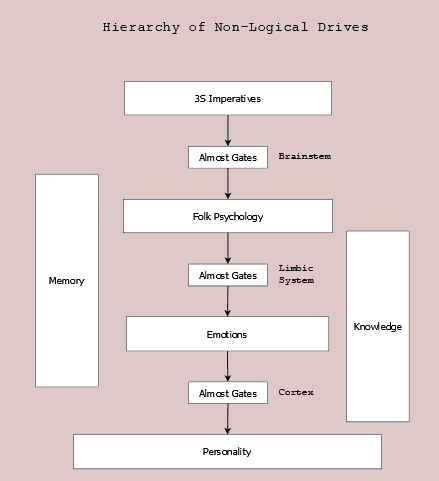
What is a hierarchy of non-logical drives? It is the order these drives emerge in the brain and their relative primitiveness.
Emotions are non-logical drives of the choices we make. They are non-logical. They arise from our genetic heritage and our personal experience rather than from logical deduction.
However, one we recognize these emotional aspects of situations we can use logical to determine how we deal with the emotion and yet we must also acknowledge that when we don’t have sufficient information to draw a firm logical conclusion, what we often do is select by similarity with the implicit hope that the differences are minor enough to be ignored.
Let’s consider how these non-logical, but fundamental premises of our internal worldview (mindset) arise.
3S Imperatives
At the top of the figure above, are the 3S Imperatives. They are Satiety, Sex, and Safety.
- Satiety is satisfaction of biological necessities. It originates with the need of the organism to maintain satisfactory physiological conditions. This imperative, called homeostasis, incites actions which keep the organism’s internal conditions within a biological optimal range. In humans, homeostasis involves levels of oxygen (breathing), concentrations of minerals like calcium and potassium as well as energy-providing glucose in the blood.
- Sex is the imperative to propagate one’s species. It arose long ago in our biological ancestors.
- Safety is concern with individual safety, which arose when memory became long-term and cognitive capacity became sufficiently strong that the result of actions could be foreseen before they were taken.
Individually they are binary–either satisfied or unsatisfied. The Satiety, Sex, and Safety are all-or-nothing demands upon our behavioral choices which are considered before most of the human brain is engaged. The current situation is evaluated by the brainstem for satisfying each of these imperatives.
Our civilizations have delivered us situations in which these demands are most met, rarely do we need to act on these all-or-non impulses. We are faced with situations that provide opportunity for partial satisfaction of each–Satiety, Sex, and Safety.
Folk Psychology
Folk psychology is the psychology that is built into our language which we use to explain why we make choices and feel certain ways. Needs, desires, and fears are the three basic components of folk psychology. As the figure shows, folk psychology arises from Almost Gates summarizing the partial satisfactions of the 3S Imperatives achieved by the brainstem and delivering that to the limbic structures, like the amygdala, know to be the locus of fear and emotional reactions.
- Needs blend the immediate requirements of homeostasis with those demands for security and sexual encounters.
- Desires summarize the potential satisfaction across particular situations that might arise as envisioned by our worldview.
- Fears are also summarized potentials, but of negative results in our fundamental needs for satiety, sex, and safety.
The elements of folk psychology are not binary, but multi-valued, providing us with a better ability to respond to tremendous varieties of situations.
Yet these terms are but clumsy attempts of our conscious mind to categorize drives that arise deep below the conscious mind. Within the limbic system, our conscious attention attributes emotions to our reactions to situations.
Emotions
Emotions have greater nuance than the folk psychology which grounds our understanding of them. Let’s take the basic emotions as anger, disgust, fear, happiness, sadness, and surprise (although there is debate about how best to delineate the emotions).
For our purposes, the emotions are derived impulses in our particular worldview which incorporate personal experiences. Our needs, desires, and fears are faced with an immense variety of situations. Those situations can provide satisfaction for our needs, but not our desires. Or they may offer satisfaction for our desires, but only in the presence of fears we have. The folk psychological elements are presented with more potential outcomes–good, bad, and indifferent–that we devised emotions to capture the important combinations, for use in our higher cogitation.
Personality
The cortical lobes receive information of an emotional nature as well as sensory data. And in its turn, it sends instructions, bodily movements and speech commands, to the body in response to each situation. Personality is the term for our stable response to daily life. It explains the habitual responses that we make to routine situations. I am a fan of the Big 5 or OCEAN personality description.
- Openness to experience
- Conscientiousness
- Extraversion
- Agreeableness
- Neuroticism
Whether you are relatively open to new experiences or not is not a logical decision. It is the result of drives, earlier in the non-logical hierarchy. Similarly to the other elements of personality.
For course, if a person is conscientious, that person will likely use logical to achieve the level of conscientiousness their personality demands. Although the drives are non-logical, that does not forbid the use of logic to achieve them. In fact, using logic on them is the norm, not the exception.
Non-Logical Drives
I hope you’ve enjoyed this little jaunt up the terminology and origin of non-logical drives in the brain. Because of the focus, I did not delve into issues of another type of non-logical thinking–using similarity and induction.
If you are interested in the inductive and more creative aspect of the brain, take a look at the Many Faces of Induction.
